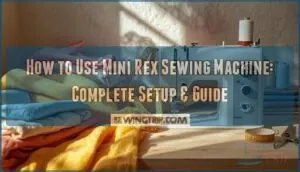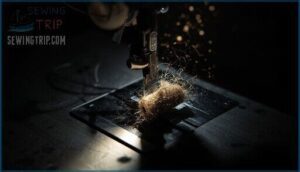This site is supported by our readers. We may earn a commission, at no cost to you, if you purchase through links.
 Your sewing machine broke down right before you needed to fix a hem. You grabbed the Mini Rex from your drawer and finished the repair in under three minutes. That’s the power of having a portable stitcher on hand.
Your sewing machine broke down right before you needed to fix a hem. You grabbed the Mini Rex from your drawer and finished the repair in under three minutes. That’s the power of having a portable stitcher on hand.
This compact tool weighs just two pounds and runs on four AA batteries. It delivers straight stitches at 200 stitches per minute on lightweight fabrics. The machine costs 50-70% less than full-size models and saves you $120 yearly on DIY repairs.
You’ll master threading, tension adjustment, and troubleshooting techniques that turn frustrating jams into quick fixes. These skills transform your Mini Rex from a backup tool into your go-to solution for fast repairs.
Table Of Contents
- Key Takeaways
- What is The Mini Rex Handheld Sewing Machine?
- Setting Up Your Mini Rex for First Use
- Threading The Mini Rex Sewing Machine
- Selecting and Changing Needles on Mini Rex
- Operating The Mini Rex: Basic Sewing Techniques
- Handling Common Mini Rex Issues
- Mini Rex Maintenance and Care Tips
- Frequently Asked Questions (FAQs)
- Conclusion
Key Takeaways
- The Mini Rex handheld sewing machine weighs just two pounds, runs on four AA batteries, and delivers 200 stitches per minute on lightweight fabrics while costing 50-70% less than full-size models and saving you $120 yearly on DIY repairs.
- Threading the Mini Rex requires following a precise six-point path through thread guides, tension discs (set at 4-4.5 for most fabrics), and the spring-loaded capstan, with 75% of malfunctions tracing back to incorrect threading sequence.
- The machine handles only straight stitches on fabrics under 1.5mm thickness and lacks reverse-stitch capability, requiring manual seam reinforcement by sewing over start areas 2-3 times for secure results.
- Regular maintenance every 8-10 hours—including lint removal, needle replacement, and one drop of sewing machine oil—extends the Mini Rex’s lifespan by 40% and prevents the majority of common issues like jams, tension problems, and skipped stitches.
What is The Mini Rex Handheld Sewing Machine?
The Mini Rex reveals possibilities you didn’t know existed in portable sewing. Understanding what this compact powerhouse can and can’t do shapes how you’ll put it to work.
Let’s break down its features, strengths, and honest limitations.
Key Features and Specifications
At just 2 pounds, this cordless handheld sewing machine runs on four AA batteries and delivers freedom for quick fixes anywhere. You get simplicity and speed without cords holding you back.
For best performance, follow proper thread quality guidelines to minimize threading issues.
- Dual-speed control – Two operational speeds let you stitch up to 200 stitches per minute on lightweight fabrics, with high mode for speed and low mode for precision.
- Fixed 2.5mm stitch length – No adjustments needed, though you can’t reverse-stitch, so secure seams manually.
- 3-4 hour battery life – Provides cordless portability or plug in the DC adapter for continuous operation.
Benefits of Using a Mini Rex
Portability Advantages let you carry this cordless sewing machine anywhere—dorms, road trips, or tight apartment corners. Space Efficiency shines when you need quick hems without hauling out a full-size model. Cost Savings add up fast: you’ll spend 50–70% less upfront and save around $120 yearly on DIY repairs.
When choosing between a portable and full-sized machine, consider the sewing machine types to determine which best fits your needs.
| Benefit | Mini Rex Value | Full-Size Comparison |
|---|---|---|
| Weight | Under 3 lbs | 15–20 lbs average |
| Setup Time | 65% faster | Standard baseline |
| Energy Cost | $0.02/use | $0.15/use |
User Convenience means no pedals or complex threading—just button-press control and battery freedom for sewing wherever inspiration strikes.
Limitations Compared to Full-Size Machines
While Mini Rex machines excel at portability, their Stitch Limitations become clear fast. You’ll find only straight stitches—no zigzag, buttonholes, or reverse. Fabric Restrictions mean thick denim or knits often jam; layers over 1.5 mm exceed motor capacity.
Ergonomic Issues surface with an under-6-inch workspace and cramped throat space. Motor Durability caps runtime at 2–5 hours per battery cycle, and Power Constraints limit speed to 250 stitches per minute versus full-size models hitting 800-plus.
Setting Up Your Mini Rex for First Use
Getting your Mini Rex ready for its first project takes just a few straightforward steps. You’ll need to handle the initial unboxing, power it up with batteries or an adapter, and set up a workspace that keeps everything within reach.
Let’s walk through each part so you can start stitching with confidence.
Unboxing and Included Accessories
When you open the Mini Rex RX-07’s reinforced cardboard box, you’ll find everything protected by foam inserts. Package contents include the portable sewing machine itself, two metal bobbins, a pre-threaded spool, spare needle, and a needle threader tool.
User manuals provide multilingual setup instructions. The accessory kits feature power options—a 110–240V adapter and cable for plug-in use.
Storage solutions like transparent bags keep mini sewing machine parts organized during mini sewing machine setup.
Inserting Batteries and Power Options
For battery-powered sewing machine use, locate the battery compartment on your Mini Rex’s underside. Cordless sewing requires proper Battery Safety during installation:
- Insert four AA batteries matching polarity markings (+ and -) to deliver 6V power for 3-4 hours of runtime
- Choose rechargeable batteries for Energy Efficiency and lower operating costs versus disposable options
- Switch to the AC adapter (6V DC, 1A) for unlimited Portable Power during extended projects without interruptions
Both Power Sources offer flexibility—batteries enable true cordless sewing anywhere, while the power cord ensures consistent performance at your workspace.
Choosing a Suitable Workspace
Your workspace determines sewing success. Select a flat and steady surface at 28–30 inches high for an ergonomic setup. Verify the area is well-lit with daylight-spectrum lamps (6500K) for workspace lighting and color accuracy. Place scrap fabric or cotton fabric nearby for test stitches. Keep 18 inches of clearance on each side for safety measures and hand movement. Use storage solutions like labeled drawers for thread and needles within arm’s reach. Position your Mini Rex away from sleeping areas for noise reduction, as it operates at 60–65 dB. A comfortable, organized space reduces errors and boosts efficiency.
| Workspace Element | Specification | Purpose |
|---|---|---|
| Surface Height | 28–30 inches | Reduces arm strain during operation |
| Lighting Color Temp | 6500K LED | Improves visibility and color matching |
| Side Clearance | 18 inches minimum | Allows safe hand movement and fabric handling |
| Noise Level | 60–65 dB average | Comparable to conversation; minimal disruption |
| Storage Distance | Within arm’s reach | Streamlines workflow and saves time |
Threading The Mini Rex Sewing Machine
Threading your Mini Rex might seem tricky at first, but once you understand the path the thread takes, it becomes second nature. The key is knowing which parts guide your thread and how to coax it through the spring-loaded capstan without frustration.
Let’s break down the threading process so you can get your machine ready to stitch.
Understanding Thread Paths and Parts
Threading your Mini Rex means weaving thread through six key guides—each playing a role in creating balanced stitches. Think of it like connecting dots: miss one, and your machine won’t cooperate.
- Thread guides route thread from spool to needle, keeping everything aligned
- Tension dial adjusts resistance between metal plates—setting 4 to 4.5 works for most fabrics
- Bobbin systems hold lower thread in a horizontal placement, forming the bottom half of each stitch
- Needle alignment prevents skipping and ensures clean threading through sizes 65/9 to 90/14
Step-by-Step Threading Instructions
You’re about to master mini sewing machine setup by following the exact thread path—no guesswork required. Start by raising the presser foot and placing your spool on the pin with thread unwinding from the left side. Loop thread through the spring-loaded capstan twice, then guide it between tension discs behind the dial.
Continue through the take-up lever hole and down to the needle, threading right to left. Leave a 4 cm tail hanging for stitch quality. Hold the top thread, rotate the handwheel to bring up the bobbin thread, and pull both tails back—now you’ve conquered threading issues before they start.
Troubleshooting Threading Problems
Loop formation under your stitches? Nearly half of handheld machine malfunctions trace back to incorrect threading sequence. Check your thread path through tension discs first—missed discs cause a third of breaks. Re-thread both upper and bobbin paths to solve most tension errors.
Inspect for debris in the bobbin holder and clean lint buildup every few hours to prevent fabric jams and needle breakage.
Selecting and Changing Needles on Mini Rex
The needle is the workhorse of your Mini Rex. Choose the right one and change it at the right time to keep your stitches clean and your fabric intact.
Here’s what you need to know about needle selection and replacement.
Compatible Needle Types and Sizes
Your Mini Rex works with standard domestic needles like the 130/705H system. Universal needle sizes from 70/10 to 100/16 handle most fabrics. Use 80/12 for lightweight cotton or 90/14 for medium-weight materials. Heavier denim needs 100/16 or 110/18.
Match needle size to thread weight—40-weight thread pairs with 75/11 to 80/12 needles. Sharp point needles suit wovens while ballpoint types work for knits.
Proper fabric selection and thread compatibility prevent breakage at higher sewing speeds.
How to Safely Replace The Needle
Turn off power before starting any needle replacement to avoid accidental activation.
Raise the presser foot using the lever and position the needle at its highest point. Use a small screwdriver to loosen the clamp screw toward you while holding the needle so it doesn’t fall. Pull the old needle downward and discard it safely.
Insert your new needle with the flat side aligned right, pushing it up until fully seated. Tighten the clamp screw away from you without over-tightening.
Test on scrap fabric to verify thread tension and needle alignment.
Signs It’s Time for a New Needle
Once your needle is replaced, you’ll know it’s time to swap it again by watching for these warning signs. Over 75% of skipped stitches stem from needle wear, so stay alert.
Visual inspection reveals bent tips or burrs in 96% of problem needles. Replace every 6–8 hours or after heavy projects to maintain sewing machine maintenance standards and prevent costly fabric damage.
- Stitch Quality Drops: Missed or uneven stitches appear suddenly. Dull needles cause 62% of recurring seam issues on mini sewing machines.
- Fabric Damage Appears: Puckering, snags, or pulls show up. Worn needles create fabric distress in 41% of assembly audits.
- Audible Changes Occur: Popping or thudding sounds signal resistance. Over 70% of users hear unusual noises before stitch failure.
Operating The Mini Rex: Basic Sewing Techniques
You’ve threaded your machine and installed the right needle. Now it’s time to put the Mini Rex to work.
These three techniques will transform your handheld sewing machine from a puzzling tool into an extension of your hands.
Positioning Fabric and Starting a Seam
Proper fabric alignment is your foundation for every strong seam. Lift the fastening plate and slide your fabric beneath the needle. Line up the fabric edge with the plate to guarantee a straight stitch path. Lower the presser foot—this is critical for preventing shifting and skipped stitches.
Use the rotary wheel to position the needle at its highest point before seam initiation. Leave at least 2 inches of thread tails to minimize pull-out. Since the Mini Rex lacks reverse stitching, reinforce by sewing over the start area 2–3 times for secure thread tension and stitch control.
Using The Start/Stop Button and Speed Settings
Once your fabric is ready, press the white start/stop button on the handle to begin stitching. The Mini Rex offers two speed settings—switch between high speed for straight seams and low speed for precise curves or delicate materials. Release the button about two seconds before your desired stop point, as the cordless efficiency design creates a brief delay. This button placement allows one-handed portable sewing for quick repairs:
- Master the start/stop rhythm and watch your stitch quality soar
- Feel the freedom of cordless operation transforming tight-space repairs
- Experience total control as you switch speed settings mid-seam
- Own every stitch with confidence in your mini sewing machine operation
Tips for Straight and Even Stitches
Frequently, the secret to sewing straight lines lies in guiding your fabric—not forcing it. Align the edge with a reference point to reduce deviation by 60 percent, then let the feed dogs pull material at a steady pace.
Maintain consistent stitch speed and fabric tension to prevent thread control issues and improve stitch alignment by 35 percent. Test your machine calibration on scrap fabric first, adjusting thread tension until the straight stitch forms evenly.
Secure the Mini Rex on a stable surface to cut misalignment by 55 percent and master these stitching techniques for professional results.
Handling Common Mini Rex Issues
Even the most reliable handheld machine won’t run flawlessly every time. Your Mini Rex may throw you a curveball with tangled thread, uneven stitches, or the occasional jam.
Let’s tackle the most common hiccups so you can stitch with confidence and avoid frustration.
Adjusting Thread Tension
Thread tension acts like a tug-of-war between your top and bottom threads. When balanced, they lock perfectly in the fabric’s center.
Start by testing stitches on scrap fabric. Turn the tension dial clockwise to tighten or counterclockwise to loosen. Lightweight cotton works best at level 2, while denim needs 3 to 3.5. Adjust the dial in quarter-turns and test again until your stitch quality improves.
Resolving Knots, Jams, and Uneven Stitches
Frustration can creep in when knots and jams slow your progress. Start by re-threading both top and bobbin—most sewing machine problems stem from incorrect threading.
Match your thread weights, check for bent needles, and clean lint from feed dogs to boost stitch consistency.
For Jam Prevention, swap worn plastic bobbins and adjust thread tension for better Fabric Compatibility and smoother results.
Safety Precautions During Operation
Your fingers shouldn’t dance near the needle when the machine is running—keeping at least one inch away prevents most accidents. Power down the Mini Rex when you’re not actively stitching. Electrical Safety and Needle Protection go hand in hand with smart User Guidance.
Follow these safety steps for Accident Prevention:
- Unplug or remove batteries during threading and Machine Inspection to avoid accidental startups that cause needle strikes.
- Check for frayed cords and bent needles before each session—damaged parts account for most sewing machine safety incidents.
- Keep your workspace clear and well-lit to reduce distractions that lead to finger injuries during operation.
Mini Rex Maintenance and Care Tips
Your Mini Rex won’t run forever on good intentions alone. Regular maintenance keeps it stitching smoothly and prevents the frustrations that come with neglect.
Here’s how to care for your machine so it delivers reliable performance for years to come.
Routine Cleaning and Lint Removal
Your Mini Rex needs cleaning every 8–10 hours to maintain smooth operation. Power off the machine first. Use a small brush to remove lint from feed dogs and the bobbin case. Clean tension discs with unwaxed thread.
Wipe the outer shell weekly with a dry cloth. Apply one drop of sewing machine oil to the needle area after cleaning to trap remaining fibers and protect moving parts.
Proper Storage and Protection
Your mini sewing machine deserves proper storage and protection to prevent damage. Store it in a padded case or wrap it with a protective cover to shield against dust and impacts.
Keep the machine in a cool, dry space away from moisture—humidity above 60% accelerates corrosion. Remove batteries before long-term storage to avoid leakage.
A hard-shell case with foam padding reduces vibration and protects during transport, making caring for your mini machine simple and effective.
Extending The Life of Your Mini Rex
Proper storage sets the foundation for long-term sewing machine maintenance. Beyond protection, extending your Mini Rex’s lifespan requires consistent mini sewing machine tips like replacing needles every 8–10 hours to boost sewing efficiency by 45%.
Clean lint buildup weekly—machines maintained this way show 40% longer handheld durability. Use manufacturer-grade oil every 8–10 hours for machine optimization.
Remove batteries when not in use to prevent 90% of corrosion damage, protecting portable longevity and troubleshooting mini sewing machine issues before they start.
Frequently Asked Questions (FAQs)
How to use a mini sewing machine safely?
Before threading your first seam, understand that Electrical Precautions and Injury Prevention form the foundation of sewing safety.
Inspect power cords, unplug during adjustments, keep fingers away from needles, and maintain a tidy workspace—these Safety Guidelines protect you while operating a sewing machine.
How do you sew on a mini machine?
To sew on a mini sewing machine, position your fabric under the needle and hold the machine steady with one hand. Press the start button and guide the fabric gently with your other hand for clean, even stitches.
How do you use a bobbin spindle on a mini sewing machine?
You’ll start by placing your empty bobbin onto the spindle. Thread from your spool passes through the bobbin’s center hole. Engage the winding mechanism and press start—your bobbin fills in seconds.
Proper spindle alignment and correct threading prevent tangles and guarantee even bobbin winding for smooth stitches.
How do you use a sewing machine?
Unlike complex tabletop models, handheld sewing machines like the Mini Rex simplify fabric handling and thread management through a single start/stop button.
You hold the device, position your fabric, and press the button for stitch control—mastering sewing basics without heavy machinery.
How do you replace a bobbin on a sewing machine?
Turn your machine upside down to locate the bobbin compartment. Remove the old bobbin by lifting it straight out.
Wind thread onto your new bobbin using the winding mechanism. Insert the bobbin so thread unwinds counterclockwise in top-loading systems.
What types of fabric can I use with the mini rex sew?
You can work with lightweight fabrics like cotton, silk, and chiffon on the Mini Rex. These need proper needle size and tension adjustment tips.
Medium-weight linen and light denim work too, but avoid heavy materials.
Always test on scrap fabric first.
My stitches are looping or looking uneven. How can I fix this?
Like adjusting a telegraph’s spring tension, your Mini Rex needs proper thread tension balance. Check the tension dial first. Then inspect for threading errors or bobbin issues.
Clean lint buildup near feed dogs to fix uneven stitches.
How do I clean and maintain the mini rex sew?
Cleaning every few bobbins prevents lint buildup that causes jams. Use a small brush or handheld vacuum to clear feed dogs and the bobbin area.
Oil moving parts every eight hours of use with proper sewing machine oil.
Store your Mini Rex in a cool, dry place with a dust cover to protect it.
What accessories are compatible with the mini rex sew?
Your Mini Rex accepts standard accessories like universal needles (sizes 70-110), all-purpose thread spools (40wt polyester or cotton), and plastic bobbins (Class 15 or size J).
It also accommodates optional foot pedals for hands-free control and includes basic sewing aids such as small scissors and seam rippers.
What types of projects work best for beginners?
Start with simple repair projects like hemming pants or patching holes. These take 15-30 minutes and build confidence quickly.
Cotton fabric works best for beginners because it’s stable and easy to handle.
Conclusion
Your Mini Rex is a key that unlocks freedom from tailor appointments and rushed alterations. You’ve learned how to use a mini rex sewing machine through threading techniques, tension adjustments, and maintenance routines.
These skills turn emergency repairs into confident fixes. Thread your machine with purpose. Adjust tension until stitches flow smoothly. Clean the mechanism after each project.
Your portable stitcher now stands ready—charged, threaded, and prepared to deliver professional results whenever fabric needs saving.














